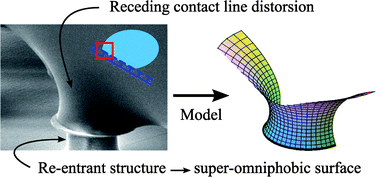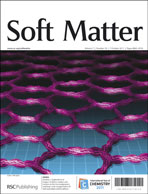Contact angle hysteresis of liquid droplets is investigated on sticky and flexible super-omniphobic surfaces made up of PDMS–Si3N4 microstructures. Up to now, extensive studies have been focusing on the relation between hysteresis and surface properties such as roughness or defect density. However, little attention has been paid to the dependence of hysteresis with respect to the liquid surface tension. In this work, advancing and receding apparent contact angles are measured on surfaces displaying 4 different defect densities with 10 water–ethanol mixtures (surface energy ranging from 72 to 21.7 mN m−1). While advancing angles are found to be constant whatever the defect density and the liquid surface energy, receding angles exhibit more complex variations. Surprisingly, we noticed a saturation of this receding angle at low surface energy. In order to explain this phenomenon, we address the receding contact line distortion from the point of view of micro capillary bridges formation and breakage. The model is supported by fine SEM observation of the local deformation and offers a new perspective to explain the underlying mechanism of the saturation phenomenon.

You have access to this article
 Please wait while we load your content...
Something went wrong. Try again?
Please wait while we load your content...
Something went wrong. Try again?


 Please wait while we load your content...
Please wait while we load your content...